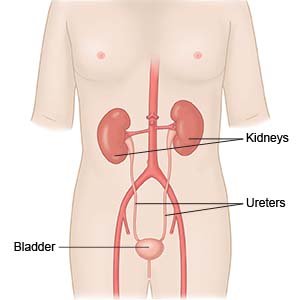Laparoscopic Live Donor Nephrectomy
Medically reviewed by Drugs.com. Last updated on Mar 10, 2025.
Laparoscopic live donor nephrectomy is surgery to remove a kidney for transplant to another person. Laparoscopic surgery is done through small incisions made in your side.
 |
WHILE YOU ARE HERE:
Before your surgery:
- Informed consent means you understand what will be done and can make decisions about what you want. The decision to donate a kidney is serious, and you must consider your decision carefully. No one should force or pressure you to donate your kidney. Your surgeon will tell you what will happen before, during, and after surgery in words that you know. You will be told which tests, treatments, or procedures need to be done. Your surgeon will tell you the risks of this surgery. He or she will also tell you the benefits the person receiving your kidney may get. Before you give your consent, make sure all your questions have been answered and that you understand what may happen.
- An IV is a small tube placed in your vein that is used to give you medicine or liquids.
- General anesthesia will keep you asleep and free from pain during surgery. You may get anesthesia through your IV. You may breathe it in through a mask or a tube placed down your throat. The tube may cause you to have a sore throat when you wake up.
During your surgery:
- Your surgeon will make 3 to 5 small incisions in your side where tools will pass through. Your abdomen will be filled with gas (carbon dioxide) to lift the abdominal wall so your surgeon can see the kidney better. He or she will use the instruments to tie, clamp, or cut blood vessels. The kidney will be removed through a larger incision in your abdomen.
- The incisions will be closed with stitches and covered with bandages.
After your surgery:
You will be taken to a room to rest until you are fully awake. Healthcare providers will monitor you closely for any problems. Do not get out of bed until your healthcare provider says it is okay. When your healthcare provider sees that you are okay, you will be taken to your hospital room. The bandages used to cover your stitches keep the surgery area clean and dry to prevent infection. A healthcare provider may remove the bandages to check your wounds.
- You will be helped to walk around after surgery. Movement will help prevent blood clots. You may also be given exercises to do in bed. Do not get out of bed on your own until your healthcare provider says you can. Talk to healthcare providers before you get up the first time. They may need to help you stand up safely. When you are able to get up on your own, sit or lie down right away if you feel weak or dizzy. Then press the call light button to let healthcare providers know you need help.
- Drains (thin tubes) may be used to remove blood or fluid from your incision.
- Medicines may be given to help prevent pain. You may also need medicine to treat or prevent nausea or an infection caused by bacteria.
RISKS:
You may get an infection or bleed more than expected. You may have trouble breathing. Your laparoscopic surgery may need to become an open surgery if problems develop. Nerves, blood vessels, muscles, intestines, and other organs may be damaged. The gas used during the surgery may cause shoulder or chest pain for 1 to 2 days after your surgery. You may get a blood clot in your leg or arm. This may become life-threatening.
CARE AGREEMENT:
You have the right to help plan your care. Learn about your health condition and how it may be treated. Discuss treatment options with your healthcare providers to decide what care you want to receive. You always have the right to refuse treatment.© Copyright Merative 2025 Information is for End User's use only and may not be sold, redistributed or otherwise used for commercial purposes.
The above information is an educational aid only. It is not intended as medical advice for individual conditions or treatments. Talk to your doctor, nurse or pharmacist before following any medical regimen to see if it is safe and effective for you.
Further information
Always consult your healthcare provider to ensure the information displayed on this page applies to your personal circumstances.
